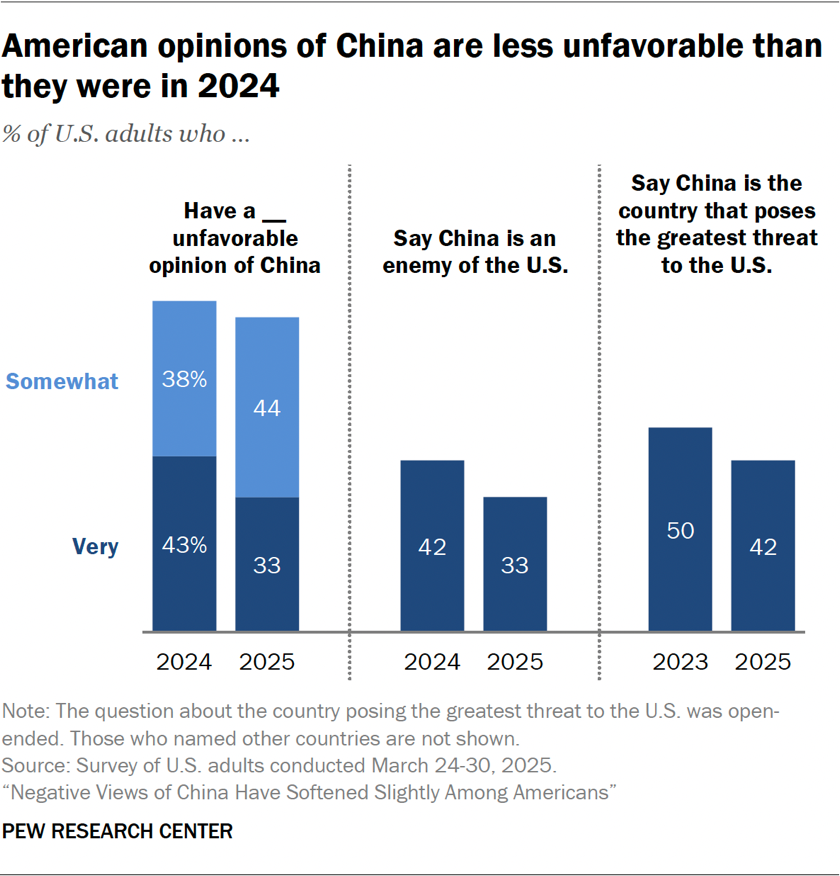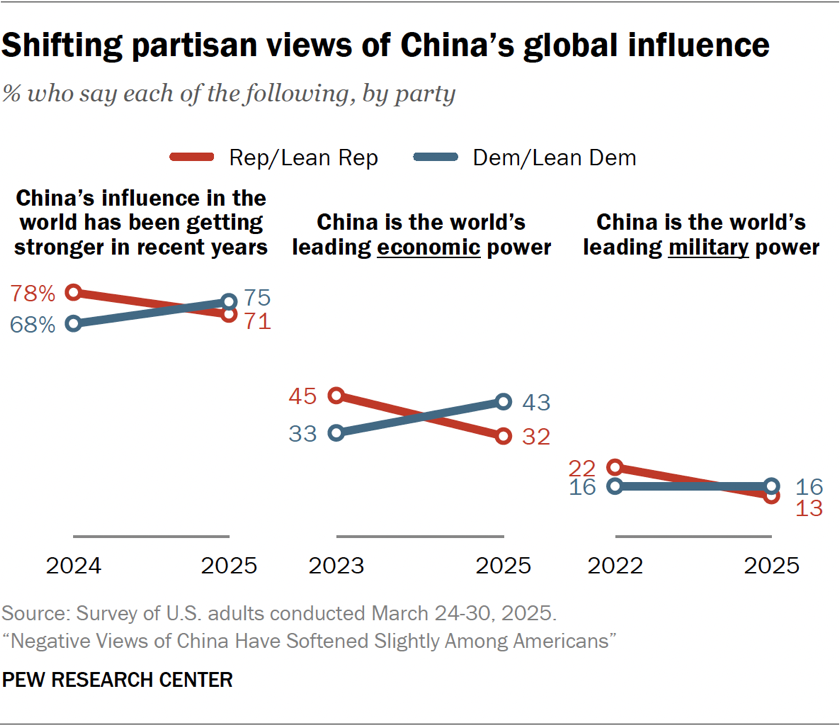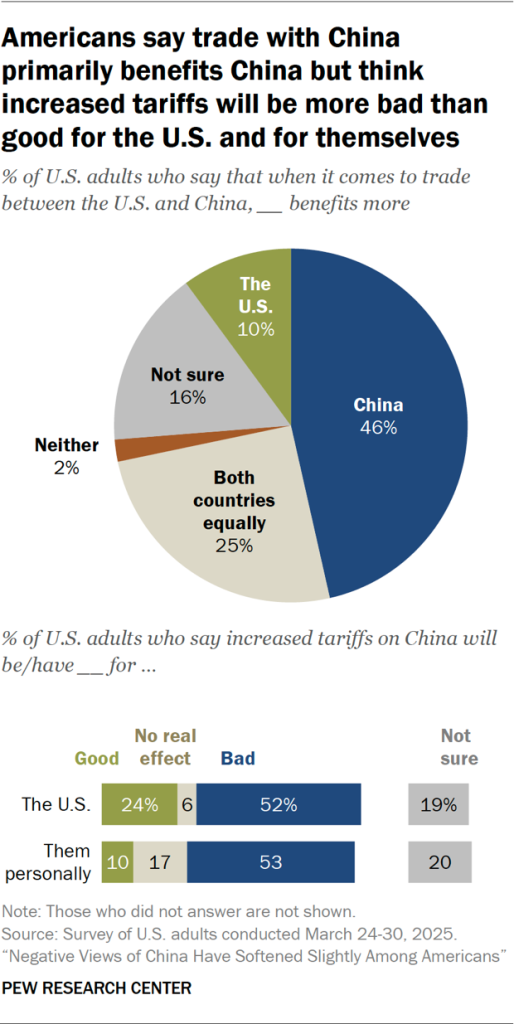Table of Contents
Over the years, China has been seen as one of the major global adversaries by a significant portion of the U.S. public. Tensions between the two nations have escalated due to economic and geopolitical competition, most notably through trade wars, technological rivalries, and military showdowns. However, according to a recent survey by Pew Research Center, there has been a slight shift in American perceptions of China. Negative views have softened, signaling a change in public opinion.
The Pew Research Center survey, conducted between March 24-30, 2025, shows a drop in unfavorable views of China compared to 2024, with a reduction in the percentage of Americans considering China the greatest threat to the U.S. Despite this, China still looms large in the minds of many as the U.S.’s most significant global challenge. Let’s explore the changes in these views and what they could mean for future U.S.-China relations.

The Shift in Attitudes
In the Pew survey, the proportion of U.S. adults who held an unfavorable view of China fell from 81% in 2024 to 77% in 2025. Even more notable is the 10 percentage point drop in the number of Americans who have a very unfavorable view of China. For the first time in five years, we see a decline in anti-China sentiment, signaling that the American public might be reconsidering their stance.
However, despite this softening of views, China remains a major concern for many Americans. The majority still consider it the country posing the greatest threat to the U.S., with 42% mentioning China in this regard (down from 50% in 2023). Though this represents a decrease, it highlights the ongoing strategic and economic challenges China poses on the world stage.
China as an Enemy
The number of Americans labeling China as the enemy of the U.S. has also decreased. About 33% of respondents view China as an enemy, down from 42% the year before. While this marks a shift, it is still a significant number, underlining the deep-rooted tension and distrust that still exists between the two nations.
Despite these changes in perception, Americans’ views on China are still heavily shaped by political discourse and the ongoing U.S.-China trade war, as President Donald Trump’s tariffs continue to strain the relationship.

Partisan Views on China
A noticeable shift has also occurred across political parties. Among Republicans, the percentage of those with unfavorable views of China dropped by 8% since last year, including a substantial 16-point drop in the share with very unfavorable views. Republicans have also moved closer to Democrats on labeling China as a competitor rather than an enemy.
Conversely, Democrats have also become less inclined to see China as the top threat to U.S. national security. The percentage of Democrats naming China as the greatest threat has fallen from 40% in 2023 to 28% in 2025. This shift could be related to increasing concerns about Russia’s aggression in Ukraine and a general reevaluation of global priorities.
China’s Growing Influence in Global Affairs
The debate over China’s increasing global influence has also seen shifting opinions. While Republicans were previously more inclined to view China’s global influence as growing, by 2025, both Republicans and Democrats are equally likely to hold this view. In fact, Democrats are now more likely than Republicans to consider China the world’s leading economic and military power.
Trade, Tariffs, and Their Impact
The U.S.-China trade relationship remains contentious. 46% of Americans believe China benefits more from the trade relationship with the U.S., compared to just 25% who think both nations benefit equally. Despite this, a majority of Americans remain skeptical about the effectiveness of increased tariffs. About half of the respondents believe tariffs will hurt the U.S. economy, while the same percentage say these measures will harm them personally.

Looking Ahead: A Balanced Approach to U.S.-China Relations
Despite the softened stance, the U.S. faces the complex task of managing its economic and strategic relationship with China. Public opinion shifts suggest that Americans are open to reevaluating their perception of China, but trade tensions, military competition, and human rights concerns continue to shape the narrative.
As U.S. policymakers work through these issues, the challenge will be to balance economic competition with cooperation where possible. The shift in public opinion could serve as a basis for future diplomatic engagement and trade agreements, yet the longstanding issues between the two countries remain significant hurdles to overcome.
Conclusion
While American views on China have softened slightly, China remains a central issue for U.S. foreign policy. Whether this shift will lead to more constructive relations or exacerbate tensions remains uncertain. However, it is clear that any future engagement with China will require careful balancing, taking into account the evolving economic dynamics, geopolitical strategies, and shifting public perceptions. With China continuing to grow in influence, the United States must develop a clear strategy that accounts for both competition and cooperation.
Author Profile
- Syed Tahir Abbas is a Master's student at Southwest University, Chongqing, specializing in international relations and sustainable development. His research focuses on U.S.-China diplomacy, global geopolitics, and the role of education in shaping international policies. Syed has contributed to academic discussions on political dynamics, economic growth, and sustainable energy, aiming to offer fresh insights into global affairs.
Latest entries
 GeopoliticsAugust 23, 2025Previewing the White House Visit of South Korean President Lee Jae Myung
GeopoliticsAugust 23, 2025Previewing the White House Visit of South Korean President Lee Jae Myung Middle East ConflictJuly 22, 2025Israel’s Deadly Attacks on Gaza: A Dire Humanitarian Crisis and International Calls for a Truce
Middle East ConflictJuly 22, 2025Israel’s Deadly Attacks on Gaza: A Dire Humanitarian Crisis and International Calls for a Truce Middle East & North AfricaJuly 20, 2025Israel Targets Damascus Amid Rising Tensions in Syria
Middle East & North AfricaJuly 20, 2025Israel Targets Damascus Amid Rising Tensions in Syria Middle East AffairsJuly 14, 2025An Open Letter from Gaza’s University Presidents: Resisting Scholasticide Through Education
Middle East AffairsJuly 14, 2025An Open Letter from Gaza’s University Presidents: Resisting Scholasticide Through Education



2 comments
I had no idea about this topic until I read your post. You’ve presented the information in such an engaging way, breaking down complex details into easy – to – understand points.
I had no idea about this topic until I read your post. You’ve presented the information in such an engaging way, breaking down complex details into easy – to – understand points.love this post